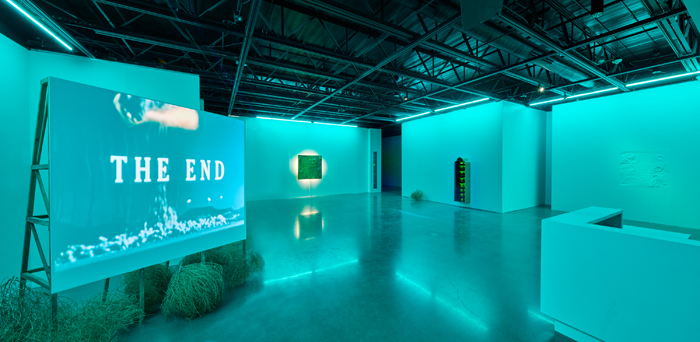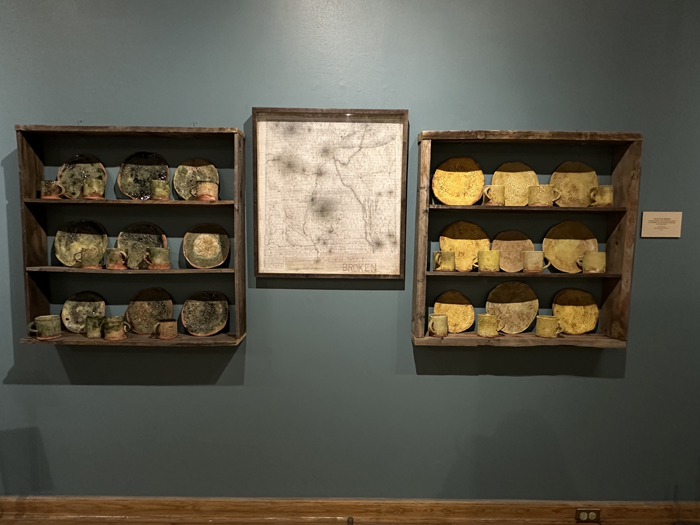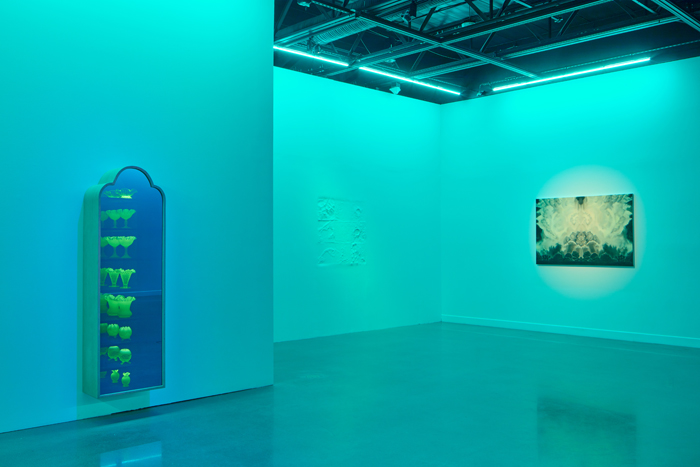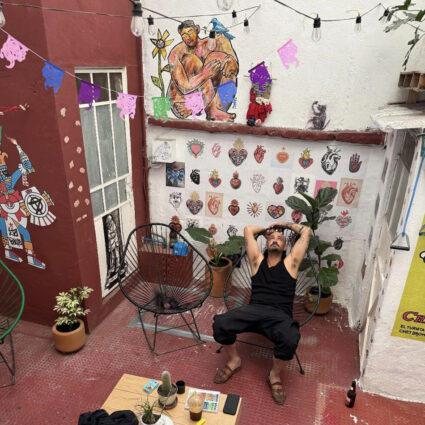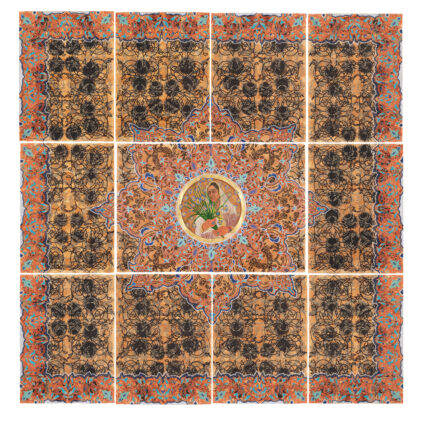Cara Despain: Specter New Mexico at the NMSU Art Museum and Trinity: Legacies of Nuclear Testing at Branigan Cultural Center examine nuclear fallout impacting local Indigenous and settler communities.
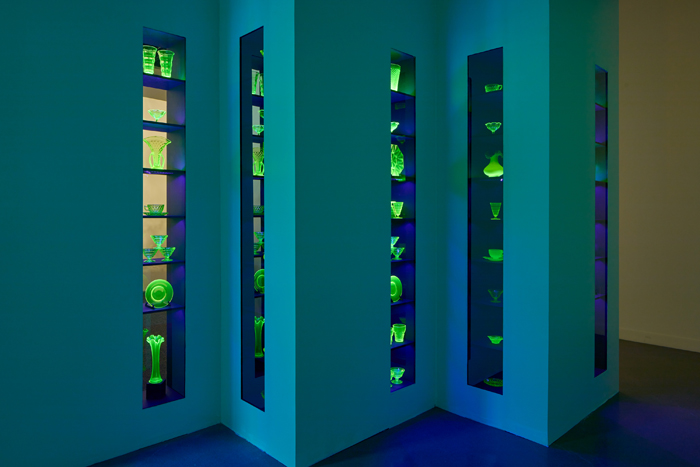
Following World War II, “fallout” became synonymous with nuclear bombs. Despite being a noun, the term carries the action of a verb. It references the trajectory of radioactive particles released into the environment, which inevitably return—fall back—as dust, settling on surfaces and seeping into dirt.
Two concurrent art exhibitions in Las Cruces, New Mexico, delve into the history and legacy of nuclear testing in New Mexico: Cara Despain: Specter New Mexico at the University Art Museum at New Mexico State University (June 6–September 16, 2023) and Trinity: Legacies of Nuclear Testing—A People’s Perspective at Branigan Cultural Center (July 15–September 23, 2023). These presentations examine fallout as a social and environmental issue, past and present, impacting both Indigenous and settler communities.
Despain’s traveling exhibition focuses on the unheard memories and histories entangled with nuclear weapons development. Her artworks activate a sensorial connection to the peoples and places impacted by colonial and industrial expansionism in the United States. Sculptures, found objects, video-based installations, and archival film and audio address the hidden cost of a post-war imaginary attempt to justify nuclear testing as an act of patriotism and national security.
Similarly, the Trinity exhibition at Branigan Cultural Center features artists-activists affiliated with the Tularosa Basin Downwinders Consortium. “Downwinders” are persons living in proximity to a nuclear test site where health risks from fallout are acute. The Consortium seeks reparations for victims of the July 16, 1945, Trinity Test.
Downwinders are continually combating the historical invisibility of fallout from domestic nuclear testing. In Specter New Mexico, Despain—who has previously confronted environmental tragedies in the American West—addresses this issue in the artwork House of Cards (2022), which consists of footage of solely end titles from Cold War-era public service announcements by the U.S. Department of Civil Defense on the threat of nuclear bombs. As the title implies, the artwork stresses the emptiness of these messages, particularly the governmental entity’s management of public perception through deceptive rhetoric of nuclear safety and survival. Ironically, it bombards audiences with a seemingly endless stream of “The End” scenes, spliced from different PSAs. These ending scenes show calm, white middle-class families, authoritative scientists and military officials, plucky cartoons, and images of mushroom clouds. Circulating these images, instead of the actual violence of nuclear testing, was a method to mentally and emotionally distance and distract the national public from the real-world effects of fallout.

Adjacent to House of Cards, another installation consists of a portable turntable, a vinyl record, and headphones, titled on the record: Hot Milk & Yellow Cake (2020). Visitors can listen to firsthand accounts of exposure to atomic testing in southern Utah and uranium mining in Monument Valley and the Navajo Nation. The “yellowcake” in the subtitle refers to the term for enriched uranium after concentration in the nuclear fission process. The confectionary jargon belies the serious health risks associated with exposure to radioactive materials. As uranium-238 decays, it turns into the isotope radon-222, which easily disperses in the air by smoke and dust causing lung damage and cancer. Radon inhalation is the greatest health concern for former uranium miners and Downwinders.
In its Trinity exhibition, the Tularosa Basin Downwinders Consortium extensively addresses uranium mining—an industry as significant to the history of New Mexico as nuclear testing. Forty-seven percent of the total uranium ore mined in the U.S. came from northwestern New Mexico with many mines located on Navajo lands. Artist Serit Kotowski’s installation Trinity Test Ware: NOT FOOD SAFE (2019) and Let Them Eat Yellowcake: NOT FOOD SAFE (2019) envisions the hazard of fallout on basic human survival by repurposing cups, plates, and saucers with sickly green and yellow patinas. “Eating and drinking have become an intergenerational death threat in the Tularosa Basin,” Kotowski explains. Respiring the air and eating from the land are all conduits of fallout. Even commercial milk from cows that eat grasses contaminated with nuclear fallout isotope iodine-131 in Downwinder areas can cause thyroid problems and cancer.
The unseen reality of humans and animals living in toxic environments carries over in Specter New Mexico. Throughout the exhibition reside dinnerware illuminated by ultraviolet lights which emphasize the iconic green tint of uranium added to the glassmaking process. This glassware was widely popular until the 1940s when the U.S. banned the use of uranium in commercial products as a means to divert resources to nuclear weapons development. The color additionally recalls the green glass formed under the explosion of the Trinity bomb which created the material called Trinitite. While these glass deposits were mostly bulldozed, it is a popular goal for tourists scavenging the site to find remaining bits of Trinitite.
Since the Trinity Test site opened for tourists, there has been a push by local activists to engage with a public who come with detached curiosity to take pictures and collect souvenirs. Trinity features several photographs of Tularosa Basin Downwinder members protesting at the test site and informing tourists about the fallout. Emmitt Booher’s photograph Tina (2018) features activist Tina Cordova holding a sign on the roadside that reads, “I got cancer living Downwind of Trinity!” Cordova’s sign informs day-trippers that the atomic test left high levels of radioactive material detectable up to the 1980s, and caused cancer in Downwinder communities.
Because of the tireless efforts of the Tularosa Basin Downwinders Consortium, the U.S. Senate, as of July 2023, approved the inclusion of New Mexico in the Radiation Exposure Compensation Act.

Both exhibitions call attention to the experiences of Downwinders living under the shadow of the mushroom cloud. Media coverage of nuclear testing often provides misleading representations because it does not show the full trajectory and impact of fallout. These exhibitions challenge this persistent invisibility with artworks demonstrating nuclear testing and uranium mining as forever ingrained in communities that unwillingly and unknowingly were changed forever by the radioactive particles dispersed by the Trinity Test.
Several events are scheduled to take place while the exhibitions are on view through mid- to late-September 2023.
-
August 17, 5:30-7 pm: “Nuclear New Mexico, What’s Next?” panel discussion with New Mexico State Senator Jeff Steinborn and reporter Alicia Inez Guzmán at the University Art Museum at NMSU.
-
August 30, 6-8 pm: A screening of The River that Harms and Under the Cloud and a virtual question-and-answer session with artist and director Pedro Reyes and artist Joanna Keane Lopez at the Rio Grande Theatre in downtown Las Cruces.
-
September 6, 11 am-noon: Downwinders panel discussion on the Oppenheimer movie at the Branigan Cultural Center.
-
September 13, 6-7:30 pm: Screening of Nuclear Savage: The Islands of Secret Project 4.1 at the Rio Grande Theatre in downtown Las Cruces.
-
September 14, 5:30-6:30 pm: Artist conversation with Cara Despain at the Zane Bennett Collection Study Room (room 106) in Devasthali Hall at NMSU.
